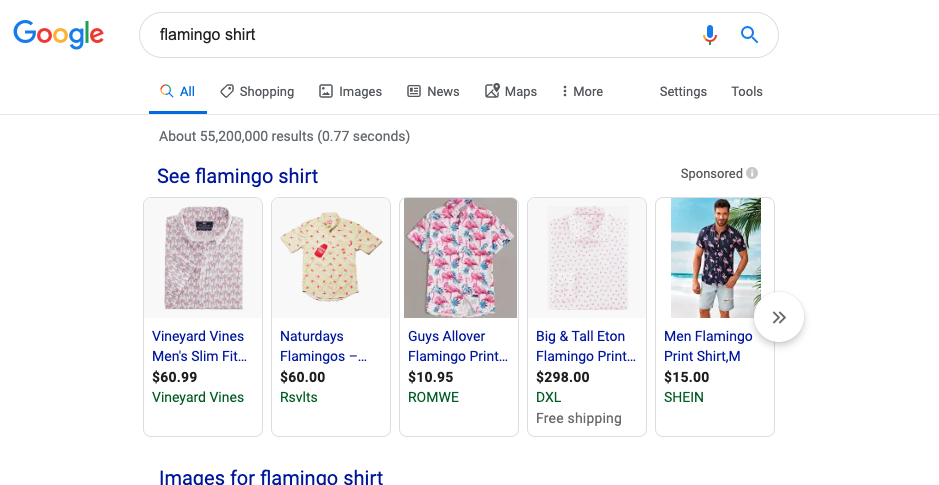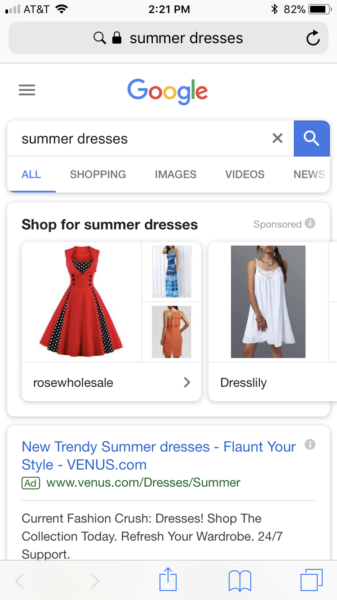The growth of Google Shopping has transformed retail search marketing over the past few years. Local stores and sellers who don’t want to be an anonymous row on Amazon are finding valuable clicks and customers through Google’s platform.
Get brand new Google ad strategies straight to your inbox every week. 23,739 people already are!
These Google Shopping statistics can shed light on just how important this advertising niche is becoming -- and where you should be applying your advertising budget.
What Are Google Shopping Ads?
Google Shopping ads or Product Listing Ads (PLAs) show your product names images and prices in Google search results. In other words, they show your offers to users before they reach your website.
That’s the good news. The bad news? Google Shopping doesn’t offer keyword targeting, which is the bread and butter of standard Google search ads.
Instead, your shopping campaigns have to be created within the Google Merchant Center, which operates the product feed that shows Shopping ads.
Pro Tip: To learn more about setting up a Google Shopping campaign for the first time, hop over to this post. We’ll be here when you get back.
Why Is Google Shopping Important?
First, visitors who click on Shopping ads tend to have a stronger intent to buy than normal text ads. Which makes sense -- these searchers have more information before they click than they would if they’d clicked a text-only ad.

A visitor who already knows what your product looks like and how much it costs and still clicks is much more likely to convert.
But that’s just one reason. The second is that Google Shopping is big and getting bigger, and it works -- especially for businesses not on Amazon.
Speaking Of Amazon...
We promised you statistics. Here’s your first one -- 85% of all product searches start on Amazon or Google. In other words, more than four out of five people who (probably) want to buy something start looking for that something on one of these two platforms.
The bigger slice of that pie belongs to Amazon, which is where 49% of product searches originate. Selling your products on Amazon can be effective, but it’s difficult to establish loyalty or long-term connections to customers there. Over time, those connections can be vital for smaller online vendors and brick-and-mortar stores.
The next likeliest place for customers to find products is Google Search, which makes up the remaining 36% of the product discovery pie we mentioned above. Unlike Amazon, however, the relative freedom of Search and Google Shopping ads provides more opportunities to build those connections.
Google Shopping Statistics: Engagement
As any romantic comedy will teach you, creating a personal connection starts with an initial interaction. In movie terms, this is called a “meet-cute.” In PPC advertising terms, we call these interactions “engagement.”
And if you’re looking for advertising engagement, Google Shopping is the place to be. Shopping ads drive 76% of retail search ad spend, and generate 85% of all clicks on Google Ads or Google Shopping campaigns.
Here are some notable areas where Google Shopping is engaging users (and advertisers), with the statistics to prove it.
Mobile Statistics
We’ve written our share of posts on the importance of mobile ads -- would it surprise you to learn that Google Shopping mobile ads are no exception?
Let’s drop a few more fun facts:
- Mobile devices generate 65% of clicks on paid Google search results.
- Before buying something in a store, 70% of smartphone users looked up information online first.
- Nearly two-thirds of smartphone users are more likely to purchase from companies whose mobile sites or apps customize information to their location.
We could go on, but you get the idea -- mobile is where it’s at. So, if you’re creating Google Shopping ads, they should be mobile-responsive at the very least. And, given that mobile traffic isn’t going away, it’s probably time to start thinking mobile-first.
Voice Assistant/Shopping Actions
Google has over 500 million assistant-enabled devices, and about half of those devices’ users prefer speaking to typing. And that doesn’t just apply to setting calendar events or turning music on anymore -- people are shopping via voice assistant too.
For that matter, 72% of voice-activated speaker owners say that using it has become part of their daily routine, and 44% of regular users say they use the device to order household items.
To engage these shoppers more effectively, Google launched Shopping Actions in 2018. Shopping Actions integrates with several of Google’s platforms, including Search, Google Shopping mobile app, Google Assistant for mobile, and Google Home devices.
The Shopping Actions system lets retailers display and sell their products through a “frictionless shopping experience” that includes shareable lists, a universal shopping cart, and instant checkout with saved payment information.
Competition
Let’s shift for a moment from how users are engaging with Google Shopping ads to how advertisers are engaging with them.
Because of the Google Shopping statistics above, retailers are actively investing in placing ads on this platform. And tracking data bears this out -- Google shopping spend grew by 41 percent from the prior year over text ads in the first three months of 2019.
What does this mean for you? Basically, that the Google Shopping ads train has already left the station -- or is well on its way, at least. Your competitors might be advertising on Google Shopping already, which means that if you’re not, you’re going to be left behind.
Traffic Share Statistics
Examining the statistics behind Google Shopping traffic -- specifically, which types of ads are getting more traffic -- can provide insights for improving performance.
And as Google develops and releases new types of ads, you’ll need to stay on top of the latest functionality to reach “hot” PPC traffic and edge out your competitors.
Showcase Shopping Ads
Showcase Shopping ads target broader searches with tiled image ads for specific retailers, as opposed to specific products. Instead of showing single products for each search, Showcase Shopping ads let you group and present related products together as a broader entry point to your brand.
A search for “women’s dresses” can trigger a Showcase ad, for example, while “women’s red snow jacket” probably wouldn’t.

Since Google introduced Showcase Shopping ads, they’ve steadily claimed a larger share of Shopping traffic. (That traffic share was just over 5% in Q3 2018, but it tripled over the previous nine months.)
Pro Tip: To learn more about Showcase Shopping Ads, read this comprehensive yet surprisingly entertaining post.
Local Inventory Ads
Google’s Local Inventory ads show users products specifically available in stores nearby. These ads are typically triggered by a product search that includes local intent, such as the words “near me.”
Connecting shoppers and local sellers by confirming that what the shopper wants is, in fact, available nearby, can be a crucial factor in completing a conversion. Shoppers are 80% more likely to visit a brick-and-mortar location if they know that what they want is there -- or better yet, waiting for them at a pick-up counter.
Users who click Local Inventory ads on mobile devices land on a Google-hosted “local storefront” that provides product details, distance to the store’s location, and store hours.
If this sounds like a lot of work to set up and maintain, especially for businesses with large inventories… well, it is. But Google is partnering with inventory management providers to help local businesses that can’t produce and manage local feeds. And by making local product availability visible online, sellers using Google Shopping can negate Amazon’s quick-shipping advantage.
Brick-and-mortar advertisers know that immediate, local product availability is one advantage they have over Amazon. Google is making it easier for these brands to push users to store locations via Local Inventory Ads.
Wrapping Up Google Shopping Statistics
If you aren’t selling your products online, hopefully, these Google Shopping statistics have convinced you that you should.
(If you still aren’t convinced and you’ve somehow read this far, maybe go read this post again? Seems like we were pretty convincing…)
And if you’re getting good (or terrible) results from your own Google Shopping campaigns, please let us know in the comments below!